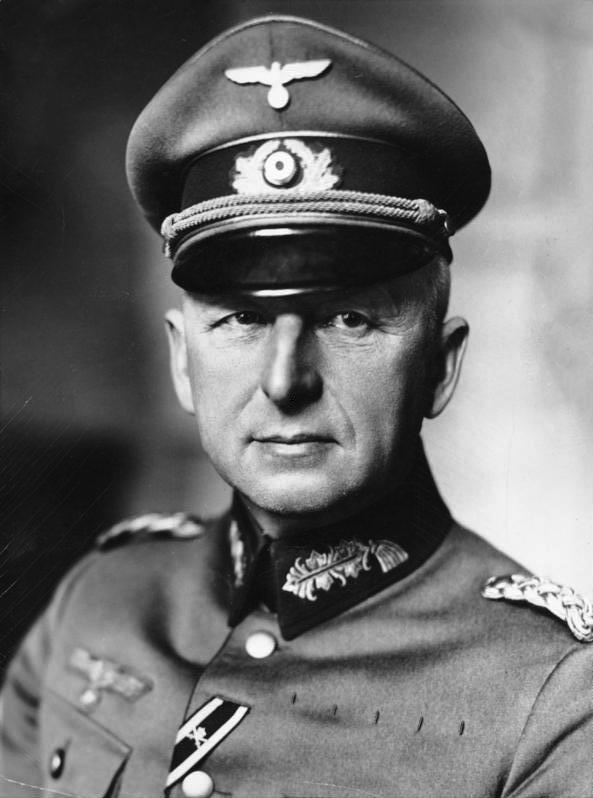Post by Haelicon on Oct 17, 2015 19:24:30 GMT
5. Italian Invasion of France
"People of Italy! Rush to arms and show your tenacity, your courage, your valor!" - Benito Mussolini speech about the declaration of war.
When Germany launched the Fall Gelb in 10 May 1940, Benito Mussolini saw a chance to prove the Italians in combat. So in 13 May, Mussolini informed Marshals Pietro Badoglio and Italo Balbo that he wants to declare war against Britain and France. They attempted to persuade Mussolini that war against Britain and France were wrong, arguing that the Italian military was unprepared, divisions were understrength, troops lacked equipment, and Italy was unprepared. But this did not change Mussolini determination.
So, in 10 June, the Italians declare war against France and Britain. Italy's goal was the end of British and French domination in the Mediterranean, reclaim historically Italian territory and the expansion of Italian influence in the Balkans and North Africa.
In September 1939, the French-Italian front was defended by the Sixth Army, commanded by General Antoine Besson, which contained eleven divisions and 550,000 men, much more than necessary to defend a well-fortified frontier. In October the Sixth Army was reduced to army detachment, renamed the Army of the Alps and placed under the command of General René Olry. By December 1939, all mobile troops were redeployed to the main front against Germany. This left Olry with three divisions, some battalions, the Alpine fortress demibrigades, and two Alpine chasseurs demibrigades totaling between 175,000 and 185,000 men.
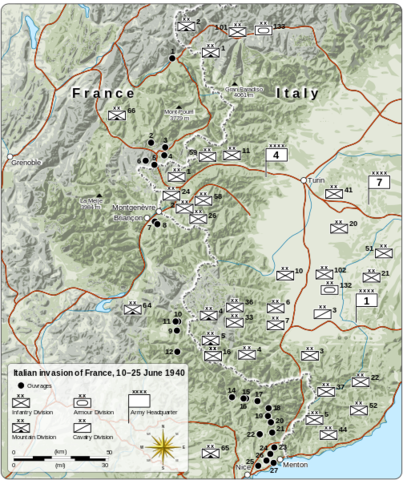
The Little Maginot
Meanwhile, the strength of Italian army had increased because of mobilization. When Italy entered the war, over 1.5 million men had been mobilized. The Italian Army had formed 73 divisions. However, only 19 of these divisions were fully combat ready. A further 32 were in stages of being formed and could be used for combat if needed, while the rest were not ready for battle.
The Italians and French employed strict defensive tactics. The Italians before the war had only planned a defensive belt around France, and not a single plan about offensive to the French territories. The French however have an offensive plan, but the worsening front against Germany made the French used defensive tactics. The French never made a single offensive to the Italians in the war.
In the first day of the war, the Italians exchanged air raids with the French and British. The British planned a bombing raid over Turin, the industrial heart of Italy. However, the French blocked the runway strip. They feared retaliation from the Italian air force. But the British still flew and bombed Turin with only 5% of the initial force. The results were unimpressive.
When the French Prime Minister Paul Reynaud resign, and Marshal Phillipe Petain were appointed as the new Prime Minister, the Italians feared that the French would surrender sooner or later. Marshal Petain announcement that he would seek an armistice with Germany confirmed this fear, and Mussolini ordered his forces to attack, no later than 21 June.
His goal were to make Italy as one of the major contributor to the war against France.
On 21 June, the main Italian offensive began.
The main Italian attack was by the Fourth Army under General Alfredo Guzzoni. The Alpine Corps primary objectives were capturing Bourg-Saint-Maurice, Les Chapieux, Séez and Tignes. After that, they were to advance on to Beaufort and Albertville. They faced strong resistance from the French, and failed to get their main objective, the Bourg-Saint-Maurice.
To the south of the Alpine Corps, the I Army Corps objective were breaking through the French forts at Bessans, Lanslebourg and Bramans and Saint-Gobain, Saint-Antoine and Sapey, which overlooked Modane and then turn north in the direction of Albertville. They had only captured the first line of French defences.
The First Army objective was the capture of Menton and the area around it. They had captured Menton, but failed to capture the area around it because of the strong artillery support that the French had. In the Armistice later, the area around Menton were given to Italy.
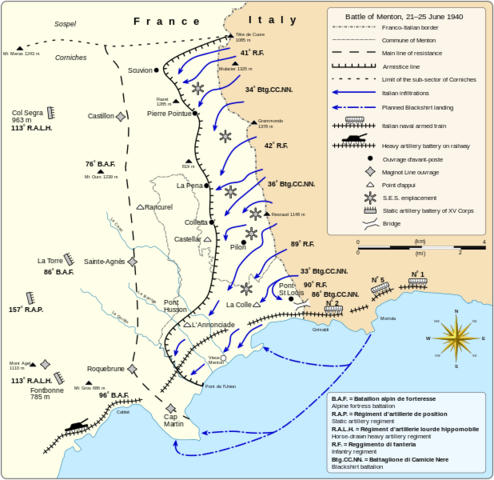
The First Army advancement
On 17 June, the French requests an armistice with Germany and Italy. Mussolini also received information from Hitler that France had asked Germany for an armistice, and he went to meet Hitler at Munich, tasking General Roatta, Admiral Raffaele de Courten and Air Brigadier Egisto Perino with making the Italy's demands. The final list of demands that presented to the French were mild, and Italy dropped its claims to the Rhône valley, Corsica, Tunisia, and the French Somaliland. According to Roatta, it was because of Mussolini's signorilità (sportsmanship) that drove him not to demand more than he had conquered.
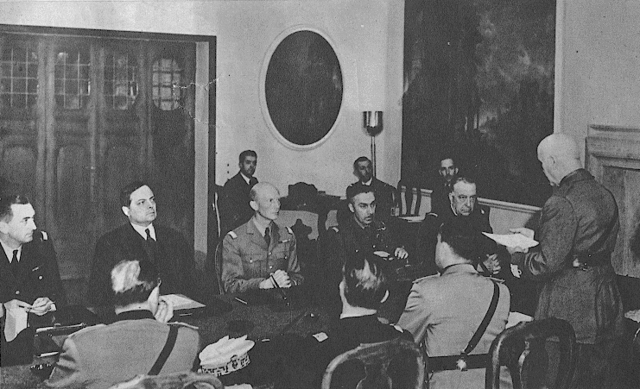
The Italian-French Armistice
The Franco-Italian Armistice established a demilitarized zone 50 km deep on the French side of the border, thus eliminating the Alpine Line. The Italians also reserved the right to intervene the Vichy France territory if needed, but did not do so until 1943.
Meanwhile, in the East, 14 June 1940, the Soviets occupied the Baltic States.
This will be discussed in the next episode.
"People of Italy! Rush to arms and show your tenacity, your courage, your valor!" - Benito Mussolini speech about the declaration of war.
When Germany launched the Fall Gelb in 10 May 1940, Benito Mussolini saw a chance to prove the Italians in combat. So in 13 May, Mussolini informed Marshals Pietro Badoglio and Italo Balbo that he wants to declare war against Britain and France. They attempted to persuade Mussolini that war against Britain and France were wrong, arguing that the Italian military was unprepared, divisions were understrength, troops lacked equipment, and Italy was unprepared. But this did not change Mussolini determination.
So, in 10 June, the Italians declare war against France and Britain. Italy's goal was the end of British and French domination in the Mediterranean, reclaim historically Italian territory and the expansion of Italian influence in the Balkans and North Africa.
In September 1939, the French-Italian front was defended by the Sixth Army, commanded by General Antoine Besson, which contained eleven divisions and 550,000 men, much more than necessary to defend a well-fortified frontier. In October the Sixth Army was reduced to army detachment, renamed the Army of the Alps and placed under the command of General René Olry. By December 1939, all mobile troops were redeployed to the main front against Germany. This left Olry with three divisions, some battalions, the Alpine fortress demibrigades, and two Alpine chasseurs demibrigades totaling between 175,000 and 185,000 men.

The Little Maginot
Meanwhile, the strength of Italian army had increased because of mobilization. When Italy entered the war, over 1.5 million men had been mobilized. The Italian Army had formed 73 divisions. However, only 19 of these divisions were fully combat ready. A further 32 were in stages of being formed and could be used for combat if needed, while the rest were not ready for battle.
The Italians and French employed strict defensive tactics. The Italians before the war had only planned a defensive belt around France, and not a single plan about offensive to the French territories. The French however have an offensive plan, but the worsening front against Germany made the French used defensive tactics. The French never made a single offensive to the Italians in the war.
In the first day of the war, the Italians exchanged air raids with the French and British. The British planned a bombing raid over Turin, the industrial heart of Italy. However, the French blocked the runway strip. They feared retaliation from the Italian air force. But the British still flew and bombed Turin with only 5% of the initial force. The results were unimpressive.
When the French Prime Minister Paul Reynaud resign, and Marshal Phillipe Petain were appointed as the new Prime Minister, the Italians feared that the French would surrender sooner or later. Marshal Petain announcement that he would seek an armistice with Germany confirmed this fear, and Mussolini ordered his forces to attack, no later than 21 June.
His goal were to make Italy as one of the major contributor to the war against France.
On 21 June, the main Italian offensive began.
The main Italian attack was by the Fourth Army under General Alfredo Guzzoni. The Alpine Corps primary objectives were capturing Bourg-Saint-Maurice, Les Chapieux, Séez and Tignes. After that, they were to advance on to Beaufort and Albertville. They faced strong resistance from the French, and failed to get their main objective, the Bourg-Saint-Maurice.
To the south of the Alpine Corps, the I Army Corps objective were breaking through the French forts at Bessans, Lanslebourg and Bramans and Saint-Gobain, Saint-Antoine and Sapey, which overlooked Modane and then turn north in the direction of Albertville. They had only captured the first line of French defences.
The First Army objective was the capture of Menton and the area around it. They had captured Menton, but failed to capture the area around it because of the strong artillery support that the French had. In the Armistice later, the area around Menton were given to Italy.

The First Army advancement
On 17 June, the French requests an armistice with Germany and Italy. Mussolini also received information from Hitler that France had asked Germany for an armistice, and he went to meet Hitler at Munich, tasking General Roatta, Admiral Raffaele de Courten and Air Brigadier Egisto Perino with making the Italy's demands. The final list of demands that presented to the French were mild, and Italy dropped its claims to the Rhône valley, Corsica, Tunisia, and the French Somaliland. According to Roatta, it was because of Mussolini's signorilità (sportsmanship) that drove him not to demand more than he had conquered.

The Italian-French Armistice
The Franco-Italian Armistice established a demilitarized zone 50 km deep on the French side of the border, thus eliminating the Alpine Line. The Italians also reserved the right to intervene the Vichy France territory if needed, but did not do so until 1943.
Meanwhile, in the East, 14 June 1940, the Soviets occupied the Baltic States.
This will be discussed in the next episode.





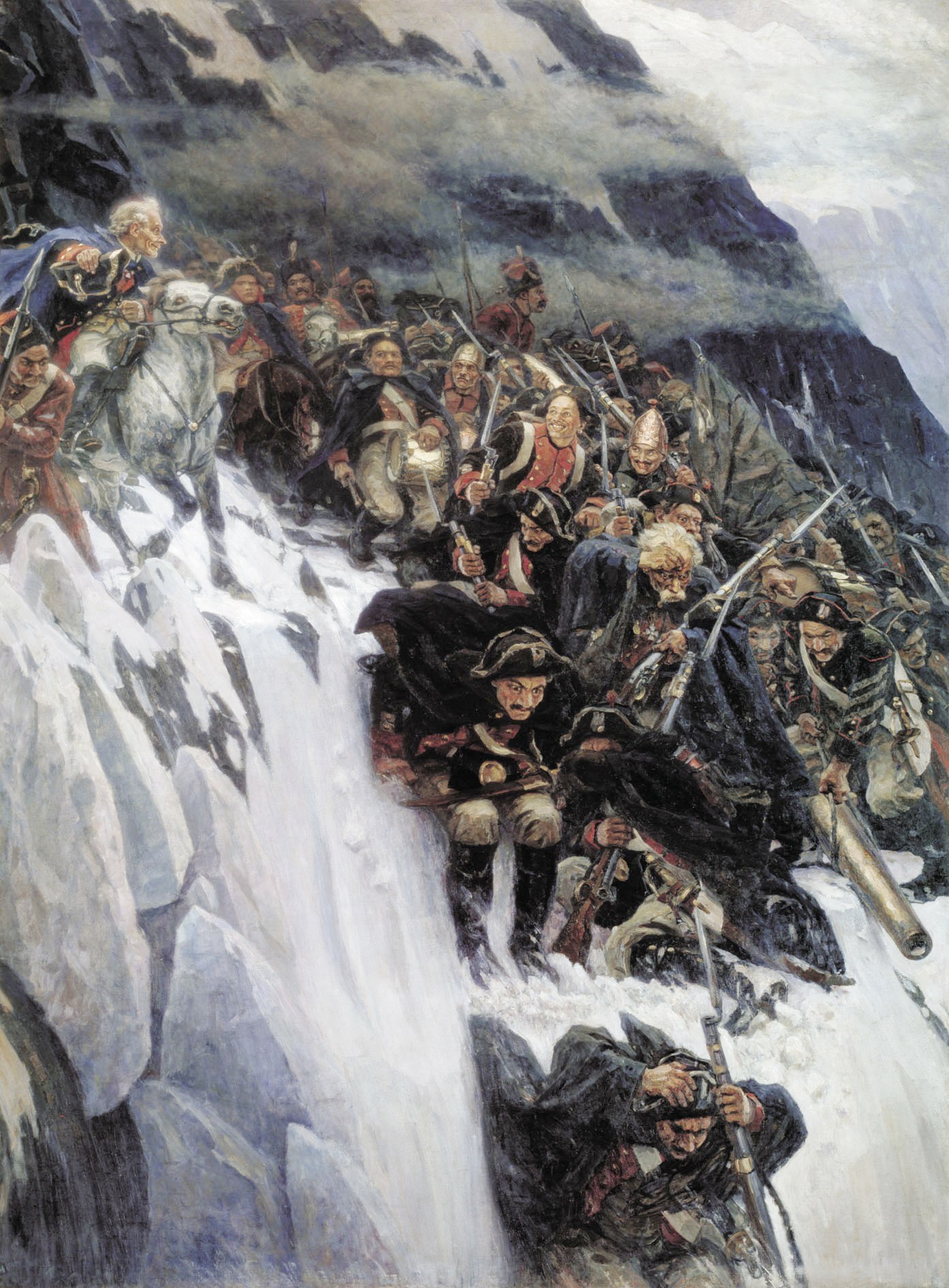




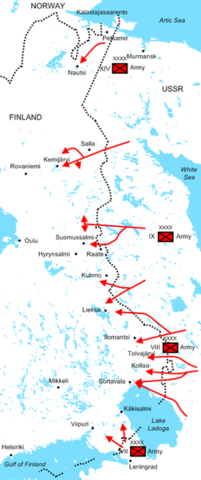

 Sorry!
Sorry! 


